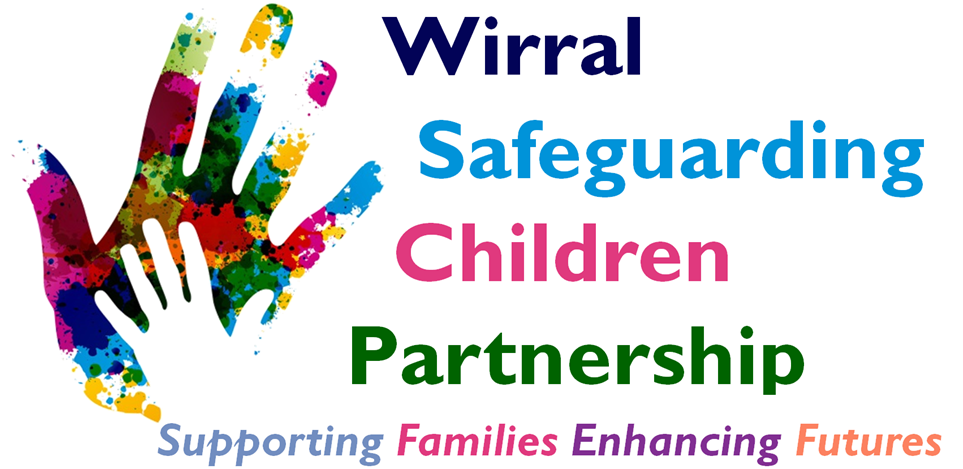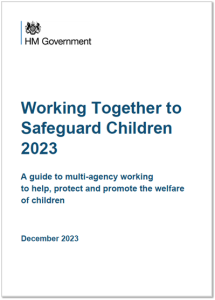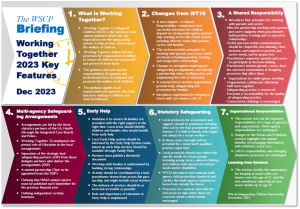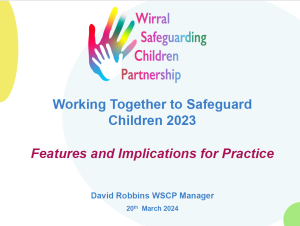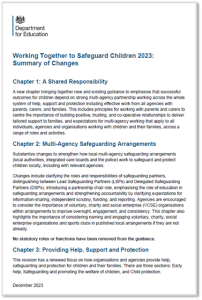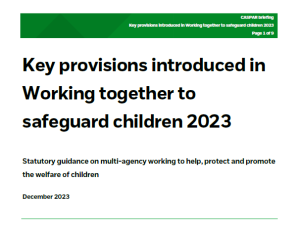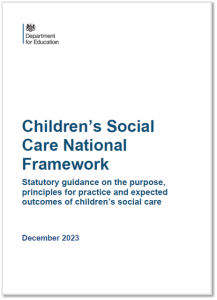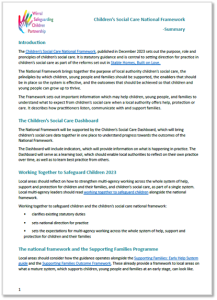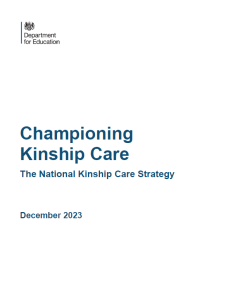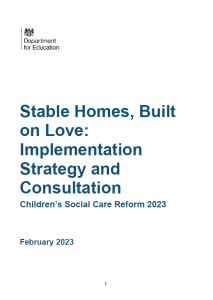Working Together to Safeguard Children (2023)
The government published the revised statutory guidance – Working Together to Safeguard Children (2023) in December 2023. The guidance replaces Working Together (2018) and applies to all organisations and professionals who work with children and young people. The guidance sets out what organisations must do to safeguard and promote the welfare of all children and young people under the age of 18 in England (25 for care leavers and young people receiving support through EHC plans).
WT23 7 Minute Briefing
Introduction to Working Together Narrated Presentation 20th March 2023
Introduction to Working Together Slides
WT23 Summary of Changes
NSPCC Summary of Key Provisions in WT23
Summary of Each Chapter:
Chapter 1 – A Shared Responsibility
A new chapter bringing together new and existing guidance to emphasise that successful outcomes for children depend on strong multi-agency partnership working across the whole system of help, support and protection including effective work from all agencies with parents, carers, and families. This includes principles for working with parents and carers to centre the importance of building positive, trusting, and co-operative relationships to deliver tailored support to families, and expectations for multi-agency working that apply to all individuals, agencies and organisations working with children and their families, across a range of roles and activities.
Chapter 2 – Multi-agency Safeguarding Arrangements
Substantive changes to strengthen how local multi-agency safeguarding arrangements (local authorities, integrated care boards and the police) work to safeguard and protect children locally, including with relevant agencies.
Changes include clarifying the roles and responsibilities of safeguarding partners, distinguishing between Lead Safeguarding Partners (LSPs) and Delegated Safeguarding Partners (DSPs), introducing a partnership chair role, emphasising the role of education in safeguarding arrangements and strengthening accountability by clarifying expectations for information-sharing, independent scrutiny, funding, and reporting. Agencies are encouraged to consider the importance of voluntary, charity and social enterprise (VCSE) organisations within arrangements to improve oversight, engagement, and consistency.
This chapter also highlights the importance of considering naming and engaging voluntary, charity, social enterprise organisations and sports clubs in published local arrangements if they are not already.
Please Note: No statutory roles or functions have been removed from the guidance.
Chapter 3 – Providing Help, Support and Protection
This revision has a renewed focus on how organisations and agencies provide help, safeguarding and protection for children and their families. There are three sections: Early help, Safeguarding and promoting the welfare of children, and Child protection.
Early help strengthens the role of education and childcare settings in supporting children and keeping them safe, including information on a child’s right to education and risk factors for practitioners to consider when identifying children and families who may benefit from early help. The approach to working with families has been strengthened throughout the guidance, outlining the role of family networks, including stronger guidance on the use of family group conferences to improve family network engagement in decision making and supporting children.
Safeguarding and promoting the welfare of children clarifies a broader range of practitioners can be the lead practitioner for children and families receiving support and services under section 17 of the Children Act 1989, and the requirements on local authorities and their partners to agree and set out local governance arrangements. It clarifies the role of children’s social care in supporting disabled children and their families, children at risk of, or experiencing, harm outside the home, children in mother and baby units (in prisons) and children at risk from people in prison and people supervised by the probation service.
Child protection introduces new national multi-agency child protection standards to set out actions, considerations and behaviours for improved child protection practice and outcomes for children. It clarifies the multi-agency response to all forms of abuse and exploitation from outside the home, consideration of children at risk of experiencing extra-familial harm in all children’s social care assessments and includes resources to support practitioners understanding of the response to online harm.
Chapter 4 – Organisational Responsibilities
Changes to the Prison and Probation sections highlights the mutual benefits of exchanging information with children’s social care which strengthen and clarify processes and responsibilities for child safeguarding.
Chapter 5 – Learning from Serious Child Safeguarding Incidents
Clarifies the expectation for keeping in touch with care leavers over the age of 21, and the non-mandatory reporting of care leaver deaths up to age 25 to improve learning and outcomes for this group of young people.
Chapter 6 – Child Death Reviews
Factual changes only
Children’s Social Care National Framework
For the first time the Government has published a National Framework for children’s social care. The Framework brings together the purpose of local authority children’s social care, the principles by which children, young people and families should be supported, the enablers that should be in place so the system is effective, and the outcomes that should be achieved so that children and young people can grow up to thrive.
The National Framework puts the voices of children, young people and families at the heart of practice, so they can have a say in how they are supported.
Children’s Social Care National Framework – WSCP Summary
Introduction to the Children’s Social Care National Framework Narrated Presentation
The National Kinship Care Strategy
Published alongside Working Together 2023 and the Children’s Social Care National Framework, the National Kinship Care strategy sets out how kinship carers will be supported as part of family networks to provide care for children within their wider family when it is not possible for their parents to care for them at home.
Stable Homes Built on Love
The National Kinship Care strategy, Working Together 2023 and the Children’s Social Care National Framework form part of the governments delivery of the Stable Homes Built on Love strategy. The strategy can be viewed below:
